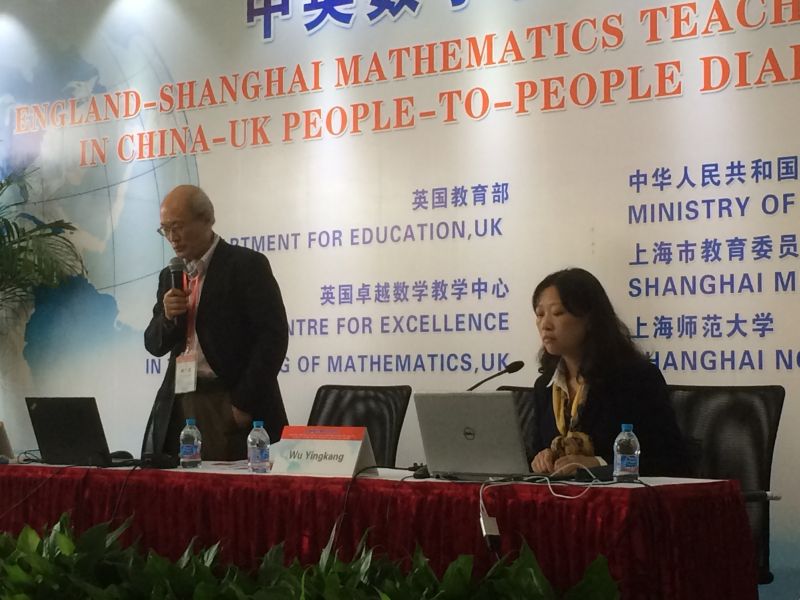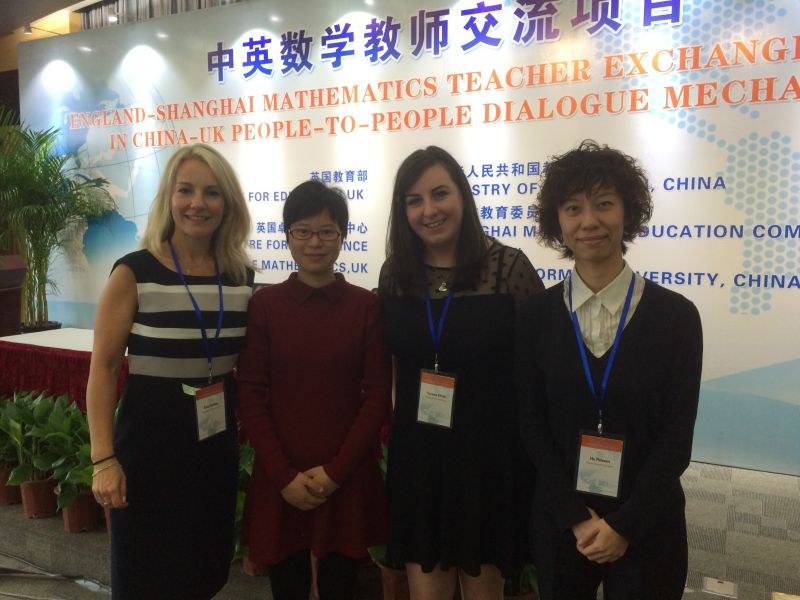Mastery Specialists Eva Brown and Serena Grear in Shanghai as part of the China - England Exchange 2016 - 2017
As part of the England-Shanghai Mathematics Teacher Exchange Project 2016, Serena Grear and Eva Brown, two of the Mastery Mathematics Specialist teachers from the South West Maths Hub, travelled to Shanghai together with 70 other Mastery Specialist teachers across England to spend two weeks in primary schools in order to gain insight into the way mathematics lessons are designed and taught. This is an incredible opportunity for professionals from both countries to share expertise and learn from each other in order to consistently improve practice and raise the standard of mathematics teaching for the benefit our pupils.
Serena and Eva decided to share their daily experience with us so keep an eye on their blogs
Serena Grear's Blog, SS Peter and Paul RC Primary School
https://mrsgrearinchina.wordpress.com/
Eva Brown and Serena Grear
Thursday 10th November 2016
Today was the big day….at least for one of our Chinese colleagues who taught her mathematics showcase lesson of the week (as they call it ‘public’ lesson).
It was quite an occasion as all delegates who were to observe gathered in the conference room to begin their introductions.
What made this extra special was that the following people also joined us:
- Charlie Strip, Director of NCETM
- Debbie Morgan, Director of Primary Mathematics in the NCETM
- The executive Head Master of the three campuses of the school
- Head Master of our school
- Director of Mathematics of the three campuses
- Doctor Wang from Shanghai Normal University (Professor of Mathematics teaching)
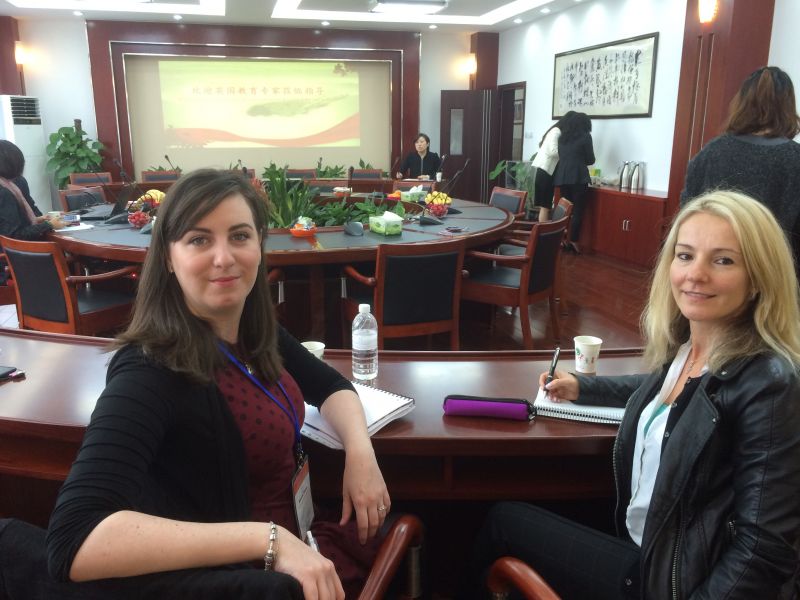
During the introductions we learnt some more facts about the school and it’s history. The teachers were very proud of their culture and achievements over the years.
They ensured us that there was a strong emphasis on the basic skills, not only in mathematics, but in writing and all other areas of the curriculum in which social skills were highlighted.
This was evident in the Head Master’s statement:
‘Social commitment and school spirit is very important, we ask every child to think much, love learning and to co-operate’.
He also declared that he was very happy to have friends that are from far away. We then discussed the importance of teacher training and how the school develops their new and young teachers. The school has a special learning culture, not only amongst pupils but teachers too where they encourage them all to continue learning, thinking, reading and writing. In fact the teaching of writing is so important that teachers themselves have specific writing lessons weekly to keep up and constantly improve upon their existing writing skills.
This takes place in the calligraphy room:
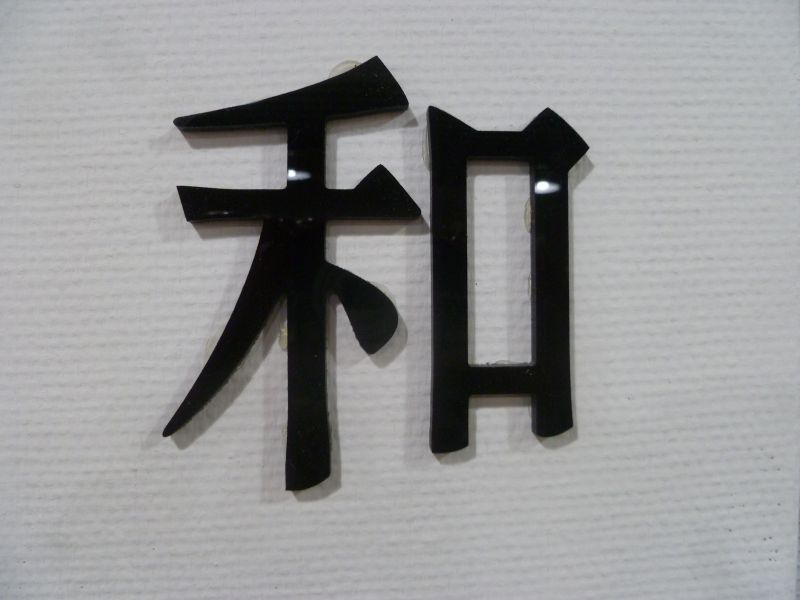 The symbols on the back wall represent the evolution of the modern symbol of the meaning of the word: song, harmony.
The symbols on the back wall represent the evolution of the modern symbol of the meaning of the word: song, harmony.
= song, harmony
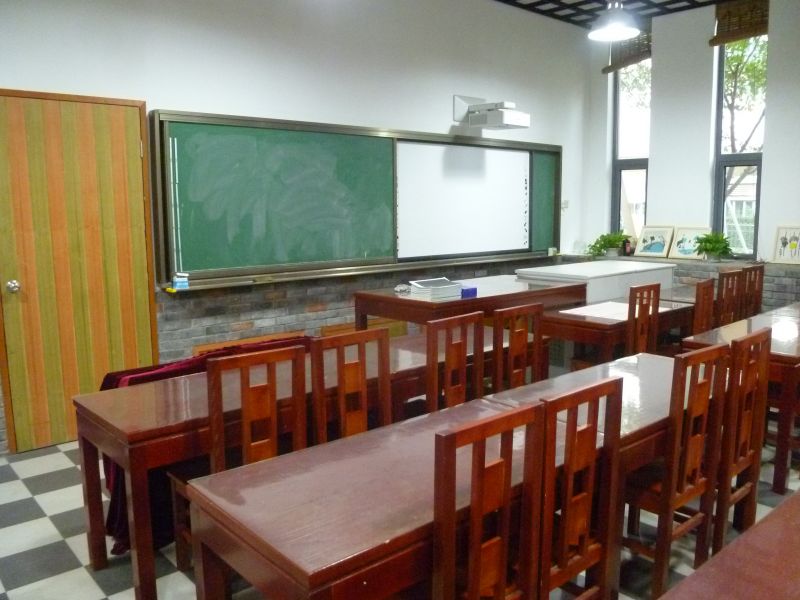
It was very inspiring to hear that all teachers have the opportunity to publish their own research projects and to show off their writing skills.
A strong theme in all of this is that collaborative learning amongst teachers, just like in the classrooms, is the center of everything. But for this to happen, team work is essential and this is replicated in everything they do.
There are curriculum teams in all subject areas, which creates a strong network of support for each other.
‘Strong team = Strong teachers = Solid foundations = Solid understanding’
The teachers are encouraged to read up on theory based on which they do action research and carry out demonstration lessons in order to constantly improve.
Research is key to finding the most effective approach to inform planning and teaching.
‘Opening the door to the world is the key to continued learning’ is a point made very clearly in discussing the collaboration between Shanghai and England.
The exchange project between the two countries work because ‘we are different and not because one is better than the other. We need to understand these differences so that we can learn from each other’.
China not only works with England but many other nations to develop an open learning society. This allows teachers to have an international vision to improve learning in their own classrooms.
I have to say that the above made total sense. Having spent now 3 days in their school, we soon came to the realisation that children are children, no matter where they come from, where they live or what their background is. It is down to the adults around them to make a difference in their lives. Chinese children are no different to the children in England. There are children that are polite, cheeky, lovely, naughty, smiley, fidgety and the rest… We all have them BUT it is how we deal with them, what we do with all the potential that is within them all – that’s what counts! ….and for some reason the Chinese have the answer within their attitude and expectations. The children just simply live up to it. That is it.
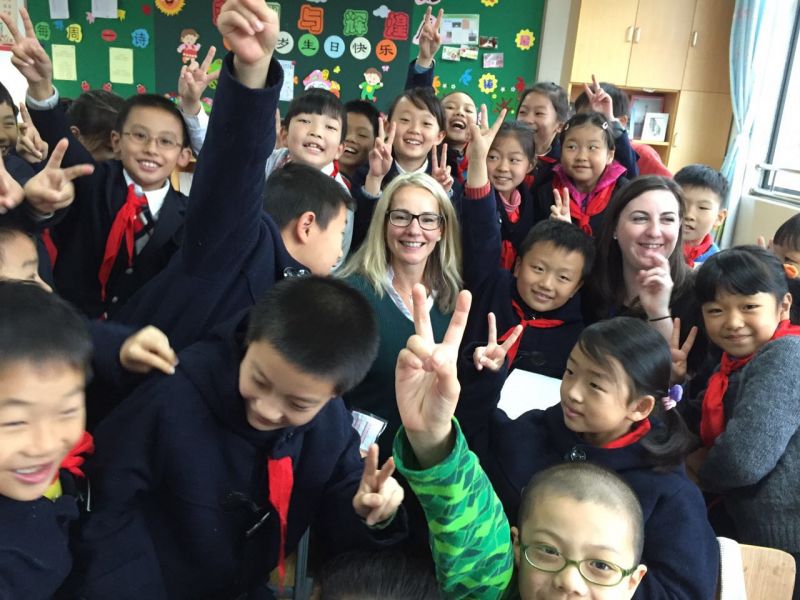
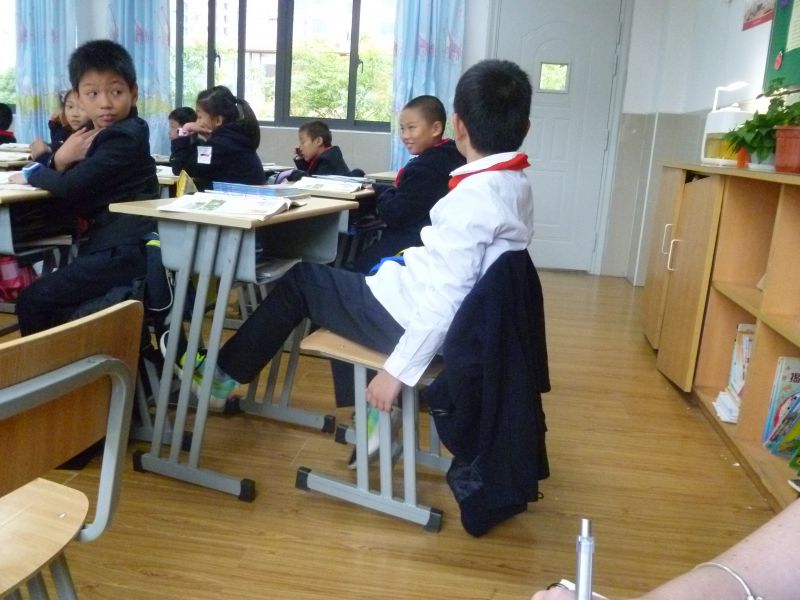
We observed Hazel’s showcase lesson, which was followed by a group discussion to unpick and analyse the teaching strategies and its impact upon learning and pupil outcomes. This group included 7 teachers, some of which were experienced and two new teachers.
Teachers were invited to contribute their reflections. The whole session had an atmosphere of positivity and it was a very open forum where all felt confident and comfortable to air their views and share ideas.
Showcase lesson Teacher Research discussion:
LO: To generalise about the relationship between odd and even numbers
Brief description of lesson
The lesson began with children studying Numicon and discussing their shape. Each of the shape was assigned its number and it was discussed why the shapes look the way they do. What is special about each of the shapes? Odd and Even was quickly introduced and children were able to explain their difference. With this knowledge in their bags, children were asked to investigate what sort of number they would get if they added two odd numbers first and then two even numbers. As children investigated using the concrete resources as well as writing it as number sentences a conclusion was drawn that O + O = E; E + E = E. This was backed up by visual imagery and children volunteering to bring their joined up shapes to the front, demonstrating using the visualiser. Number sentences to go with these visual representations quickly followed. Children investigated various numbers using these rules by trying out various number sentences but the real convincing factor was the joining of the shapes. Attention was quickly shifted onto the number lines where odd and even number on separate number lines were revealed and links were made without the use of pictures. Shift of concrete, pictorial and abstract was smooth and effective. Children then completed the challenge task of number sequences with missing numbers. They all spotted patterns quickly and their ability to recognise this is admirable.
Here are some of the comments made:
- The use of shapes, pictures and language were very important and it was clear for the children that they had to explore the situation and visualise the problems they were faces with
- Children were able to explore collaboratively, in a skillfully structured manner using their tools and to conclude for themselves using the models and images provided. They were the real leaders of the lesson, however the teacher intervened at the correct times to guide the learning in the right direction. This was pre-empted during the planning stage based on prior experience.
- There was good progress throughout the lesson from concrete to pictorial and abstract and this happened rather rapidly which posed no difficulty for the children, quickly moving into a more abstract idea of number lines.
- Careful planning provided appropriate variation to allow children to deepen their understanding.
- Children spent a long time explaining their ideas and there was evidence of the teacher having high expectations for pupils to explain their mathematical thinking through a range of questions.
- Repetition through variation and difficult points thoughtfully planned in at the right time where children had to think carefully about their answer. Discussion at these points advanced learning at a remarkable pace and let children use and apply their existing skills in a slightly different context.
- Questions were designed with microscopic progression in mind and links were constantly made to explore patterns between odd and even numbers. This let them make generalisation based on plenty of examples. Each point of the lesson was designed carefully so skills are built on existing ones with new learning added at each point.
- CT uses a range of pedagogical strategies to keep the whole class engaged – such as: whole class stand up if they think the numbers added match the rules discussed; paired discussions; whole class discussions; individual explanations; paired work using concrete apparatus; modeling by a child on visualiser; re-modelling by CT and drawing of conclusions.
- The aim of the lesson was very clear and within lesson exploration happened for a goal rather than exploration for explorations sake. Each exploration was planned with a purpose and new learning was summed up in stages after which, another new skill was introduced. This provided constant conclusions throughout the lesson, which we call the ‘mini plenary’.
The only difference is that mini plenary in England happens as a result of AfL however in these maths lessons these are meticulously planned in for a clear purpose. Lessons are taught in stages where each new learning is drawn to a mini-conclusion.
+ Generalisation happens through testing it out with a number of examples, however Numicon shapes are used to provide a convincing argument for this.
There is a discussion about the importance of children already having have memorised number facts so they can focus on the problem in hand rather than the computation.
Through discussions teachers came to a conclusion that in Chinese teaching, concrete apparatus is specifically used to provide the link between number relationships and to enable pupils to quickly move into the abstract in order to generalise, because they already possess very strong mental maths skills.Whereas in England, concrete apparatus can be used for a long time and relied upon too heavily to calculate. This means that the children often end up with a ‘cognitive overload’ and do not have enough capacity left to focus on solving the problem in hand.
Complex tasks must be made up of less complex parts so that the real learning is not lost.
While China is very good at memorisation from an early age, memorisation is needed to help develop understanding and understanding in turn is used to help strengthen memorisation.
What a thought-provoking day – their whole life revolves around positivity and they just simply believe and think the best of themselves and others around them. This has an immense influence on the way we feel as well. Throughout the week we’ve felt very uplifted and happy to be in such a positive and warm environment where you can be yourself and cannot make a mistake as mistakes are viewed as part of the learning process. Every single person in this school community, from the chefs to the cleaners, to the children and even parents radiate this sense of positivity and joy.
Happy days!
Wednesday 9th November 2016
Another fabulous day at this wonderful school!:-)
We were extremely busy last night as we were asked to teach an English lesson to a Grade 3 class today so accompanied by a bottle of wine, we set to work in the Hotel lobby on our English Powerpoint. Needless to say, it was a success! We pulled out all the stocks and acting skills, which the children responded to really well – we are not just mathematicians after all!
First thing in the morning, we had the opportunity to observe children in the kindergarten, which is right next door to the school, as they polished up on their gross motor skills in their large outdoor area through a range of physical activities.
Wow factor: incredible set of resources in plenty of supply! Happy children busily getting involved in all of the activities.
So how does the school system work in terms of age groups?

The children were given mathematics tests yesterday, which we helped mark this morning. Luckily, these were simple addition and subtraction questions within 10 so we didn’t have too much trouble with finding the answers early in the morning.
….and the result: average score is 90%+ correct answers - no wonder that all the teachers and pupils have a permanent smile on their faces.
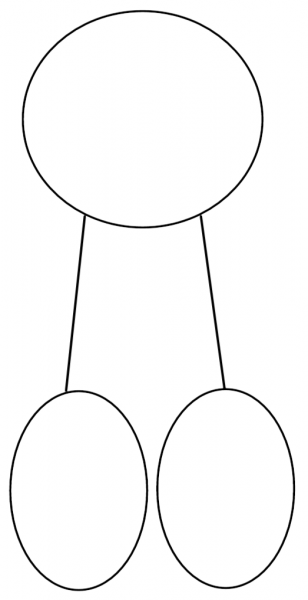 We discussed the impact variation has on children’s understanding of the relationships in addition and subtraction. For example the teachers use Part-Part Whole models to help children understand and visualise the relationships between three numbers.
We discussed the impact variation has on children’s understanding of the relationships in addition and subtraction. For example the teachers use Part-Part Whole models to help children understand and visualise the relationships between three numbers.
Teachers design equations with succinct small step variation to show microscopic progression in order for children to master the concept and this is also true when they are given tests. This allows teachers to see at what point the child is not able to cope with the difficult points.
Here is an example of what it would look like:
4 + 5 = ?
7 – 3 = ?
? + 3 = 8
4 + ? = 10
7 = ? + 3
7 = ? – 3
? – 3 = 4
Children are encouraged to estimate and check if their answer makes sense by underlining the part of the calculation they are to find and solve it again writing the answer underneath. They then check this against the equation given.
[Text Box: 7 = - 3 ] Just like this:
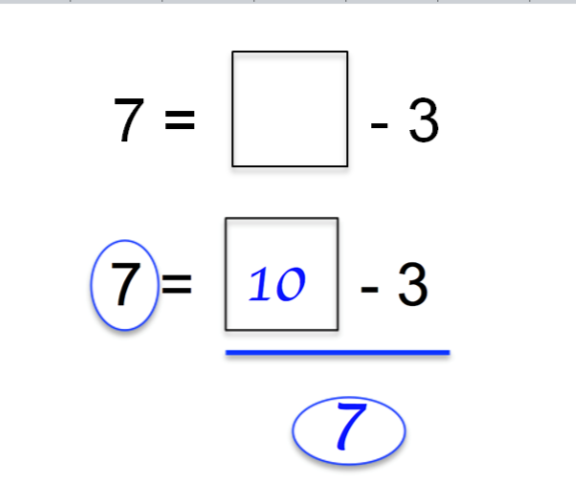
Yinan pressed that ‘checking and estimation is the most important part of maths. Children need to be reminded to do that all of the time and rewards must be given when a child does this’.
In conversation, once again, we were reminded that all of the above is not planned in isolation but in groups where maths teachers collaborate and refine their thinking through continuous discussion and a strong support network. Yinan calls this ‘Team Power’ where the maths director and excellent teachers work together to share good practice. Even though they are really busy teaching, they make sure that they find pockets of time to discuss lessons.
‘After all, all we do is for the students!’ Yinan
During our discussion, the music came on reminding us to do our eye exercise. So as we set about to begin with this, we noticed that a couple of children busily ran around corridors peering through classroom windows to check that all was in order. They were the eye exercise monitors! – Consistency is everything and it is carried out to perfection! It is clear that this has an extremely positive impact upon children’s learning.
Mathematics Lesson observations:
The highlight of today was the two mathematics lessons that we observed, one in Grade 3 and one in Grade 5. Both lessons were impressive and Serena and I learnt a lot.
Here is a running record of what was observed in Grade 5:
LO: To be able to find the value of x through equations.
- High expectations for behavior and appearance before lesson begins and all sit with arms crossed ready to learn.
- Lesson begins with mental-maths and rapid recall of multiplication and division facts. Children picked randomly to stand up and explain how they know. CT uses this opportunity to remodel some of the strategies on the board.
- CT discusses meaning of equal symbol as most important idea of balancing equations and this is evident in the amount of time she spends discussing this.
- CT models three fairly simple equations with children’s involvement to solve and explain and strategies to check is also discussed through clear and precise modeling.
Example of one of the questions:
54 + x = 78
x = 78 – 54
x = 24
Check:
54 + x = 54 + 24 = 78
78 = 78
- Lots of repetition and sharing of ideas around the equal symbol verbally, then they are given an example to solve this.
- As CT walks around a room, she uses accurate AfL and a few children’s work is purposefully picked and shared using the visualiser. This is discussed with all and CT uses this opportunity to discuss misconceptions some of the children have and remodels this on board. Children call out number sentences aloud in unison, and also explain why the calculation method used is sensible to further embed understanding.
- Questions are designed to become more and more complex as the lesson moves on (examples of equations include addition, subtraction, multiplication and division using whole numbers at first then decimal right at the very end as a difficult point).
- Tiny steps are made within the lesson and each are carefully thought out to develop skills.
Example:
54 + x = 78
65 = x + 14
342 = 9x
119 ÷ x = 7
178 – x = 38 x 3
x + 56 = 3x
- Time target is given for children to complete independent practice in between each teaching point and this means that the lesson-pace is fast and children complete 6 questions by the end of the lesson.
- It is clear that, children have a deep understanding of inverse operations and their ability to fluently calculate with these numbers mentally enables them to focus on the mechanics of solving equations rather than worrying about how to calculate with the given numbers.
- Throughout the lesson it is evident that the CT pre-empts difficult points and makes it a priority to pick up on these.
- CT consistently uses misconceptions as a teaching point with the use of visualisers and also shares various methods / strategies through discussion with children.
Final thought: Although the lesson lasts for 35 minutes only, the children have learnt an enormous amount. Every single child had completed 6 questions correctly through constant AfL and the discussion of ideas. Pace is hugely significant and all keep up because they have the basic skills to build on when learning new mathematical ideas. There is no time or opportunity to mess about or not to think because children are kept busy and engaged through a range of teaching strategies which includes modeling, sharing, questioning, discussing and the practicing of newly leant skills. When questions asked, children are expected to respond with full sentences either in unison or individually – focus, focus, focus!
Their daily homework task is given for the end of the day, which includes a page of practice of similar questions taught in the lesson so that skills are embedded further.
Lunch was a very pleasant surprise when Grade 3 children walked to the hall to have their lunch with us teachers. Two children were chosen to play the piano for us while we ate, which was announced through a microphone by a third one. The hall went silent as both, adults and children ate silently while listening to a very impressive proper little performance. We showed our gratitude with a clap at the end.
There is always something new to discover at this school – full of surprises so don’t miss tomorrow’s account of events!
Tuesday 8th November 2016
…and finally, the day we were most looking forward to. We made it into the school [Shanghai Pudong District Zhuyuan Primary School].
What joyful and happy learners!
This is a new school, opened in 2012, which is one of the campuses belonging to three sites. The school itself is surrounded by tall, modern apartment blocks, which is well looked after and serves a caring community.
The grounds of the school is certainly a wow factor, which includes several ponds, waterfall features with well established trees, shrubbery and green areas where children happily run around and play.
The sports areas are certainly admirable and well equipped with a large running track, football pitch, two basketball courts and indoor facilities to play any sort of ball game.
As we arrived, we were greeted by our partner-teacher, Yinan, her Head of department, Maths lead for the three campuses and Headteacher. They made us feel very welcome and seemed rather excited to embark on this learning journey with us. They made special arrangements to give up their busy schedule to spend some time with us discussing the plans for the week ahead over a lovely cup of ‘white tea’ and some delicious selection of fruit.
As we spent the day walking around the school, children excitedly peeped through their classroom window to discover two very unfamiliar faces walking by. They quickly turned their attention back to their teacher – after all learning is very high on the agenda here!
Walking into classrooms, all children welcomed us with a wave and a smile. During their play-time, they were eager to chat to us and show off their English language skills.
.JPG)
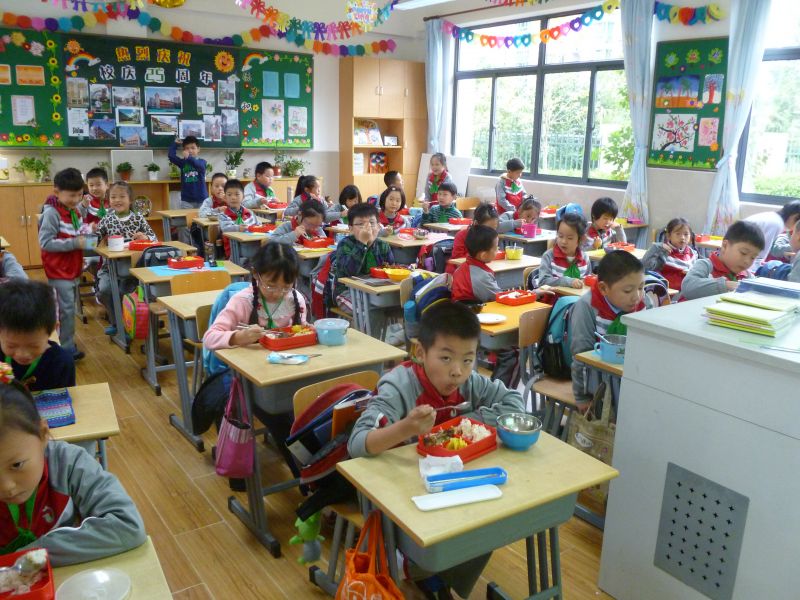
Once again, it was obvious how highly teachers are thought of in China. Cooking is exquisite and each teacher receives a free hot meal a day. How spoilt we feel! Might return with a few extra pounds – and we don’t mean our luggage!
A typical school day
Well, nothing is left for chance here, that is for certain! Tightly structured day that all works like a well-oiled machine where all play their part eagerly in this big learning game. Not a minute is wasted!
07:45 – 08:20 Children arrive to school and they begin early morning activities which
includes reading and homework activities
08:20 – 08:45 Morning exercise
08:45 – 09:20 Chinese (this is either linked to reading, writing, history)
09:20 – 09:30 Rest
09:30 – 10:05 Music
10:05 – 10:15 Rest
10:15 – 10:20 Eye exercise (we learnt this so be prepared!)
10:20 – 10:55 Mathematics
10:55 – 11:05 Rest
11:05 – 11:40 Science
11:40 – 12:00 Lunch
12:00 – 12:45 Afternoon exercise and Rest
12:45 – 13:05 Chinese writing practice
13:05 – 13:45 Computing
13:45 – 13:55 Rest
13:55 – 14:00 Eye Exercise
14:00 – 14:35 Art
14:35 – 14:45 Rest
14:45 – 15:20 English
All of the above is beautifully conducted by the sound of wonderful music that echoes through the whole school.
Teachers’ professional development is of utmost importance and well-designed facilities with ample space is built to reflect this.
For example: ‘Public lesson’ classrooms where teachers are expected to showcase lessons they are proud of to colleagues within and out of their schools.
As part of the strategic learning community every teacher observes lessons of colleagues in other schools and spend time reflecting upon these twice a week!
It is clear that this sort of learning is an embedded practice that works so well. Chinese teachers value each other’s opinion and see each other as critical friends who never stop learning from each other. We feel very grateful that we are involved in this project because we are now part of this learning culture on a global scale.
Monday 7th November 2016
We've had an incredibly inspirational day at the Shanghai Normal University, where not only did we meet our Chinese colleagues but we were also addressed by Professor Yang Xiachun (Minister of Education in China); Claire Fowler (Director for Mathematics Education at the DfE); Zhu Ziglang (Director of Shanghai Normal University) and three professors from the university: Ding Xiaodong, Zhang Minxuan and Gu Lingyuan.
Each one of these people spoke very highly of the exchange programme and stressed its significance in the development of mathematics education as we are about to embark on a collaborative learning journey in order to continue to improve and advance the learning experiences of young people in our schools. Professor Xiachun said that amongst all, this project is "one of the most important programmes" that the collaboration between China and the UK have.
We were given a lecture by Professor Gu Lingyuan on the ‘Chinese Experience and Characteristics in Mathematics Education’ although he preferred to entitle his lecture as:
‘Back to the nature and the truth:
Practices and research on mathematics teaching through variation’
He is a leading professor of mathematics education in China and bases his theories on his well-founded research projects, which explains his preference for the title. A part of his job is to observe the teaching and learning of mathematics in China and to assist the teachers to improve the learning experiences of the children in their classrooms. Professor Gu is often referred to as "the father of maths foundation", a very well suited title since he has observed over 6000 mathematics lessons as part of his research projects.
Professor Gu explained that mathematics teaching is a process in which students are enabled to learn how to “observe and organise the real world mathematically" and that this is often achieved through:
- a well thought out repetitive cycle of mathematical abstraction
- logical reasoning of understanding
- modeling using images to understand
- application of knowledge with the help of interconnected ideas in order to become better problem solvers
He focused his speech around the key importance of teaching through variation in order to help students make those important mathematical links so that they may learn how to ‘observe and organize the real world mathematically’.
His idea of moving forward from a solid starting point consistently with carefully designed sequence of teaching while grasping the ‘core connection’ from the starting point to the new learning goal resonated well with all of us as we are working so hard on making sure that all aspects of mathematical ideas are revealed while planning our sequences of lessons.
It was fascinating to hear how he picked procedural variation further apart to provide an even ‘deeper’ understanding of mathematics mastery to us all but you will hear about that during one of our training sessions!:-)
Professor Zhang Minxuan talked about the structure of Chinese Education and some of the most important aspects that we could certainly develop back home are:
The Department of Education has a 5-year plan without any change in its system. When this 5 year plan ends, slight adaptations are made for the next 5 years based on a self-evaluation system all based on well founded research projects.
Every teacher in every school is part of a well-established teacher research group in the quest to consistently improve practice because they believe that it is just as important for teachers to belong to a learning community as for the pupils.
All teachers plan together every week in order to have a professional dialogue and as part of their professional development they also observe someone else teach so they can learn from each other
Self-evaluation and reflection plays a central part in a teacher’s career development
In the afternoon, we met the teachers we will be working with for the next few weeks in China and back in England. Here is a picture with our two Chinese colleagues Hu Peiwen and Wang Yinan. We very much look forward to our first day in school tomorrow!:-)


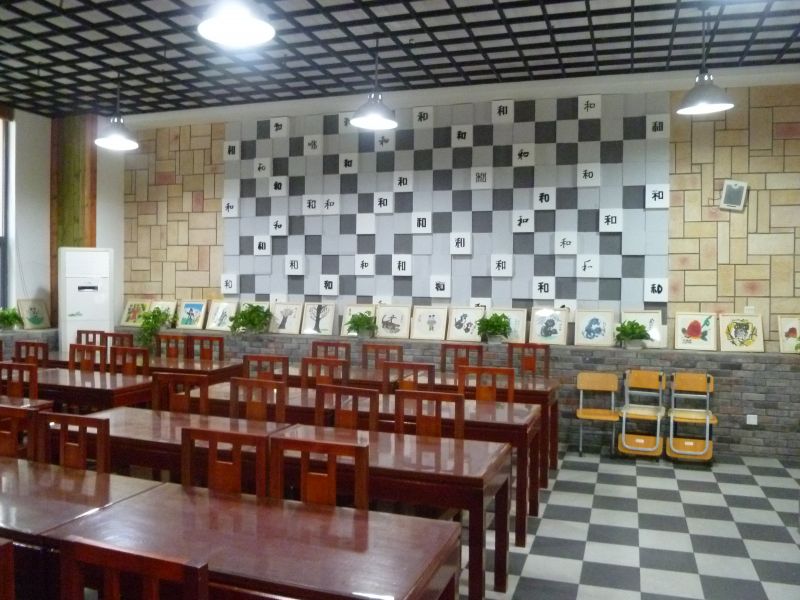
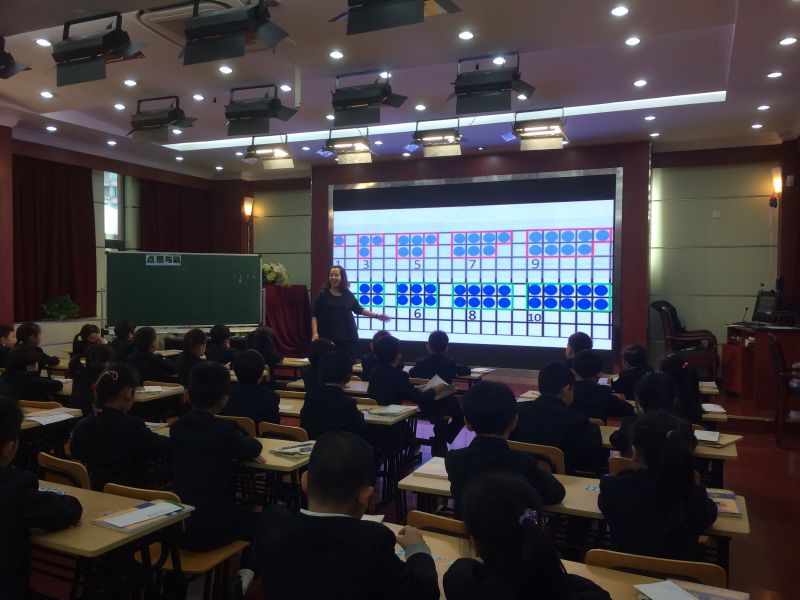

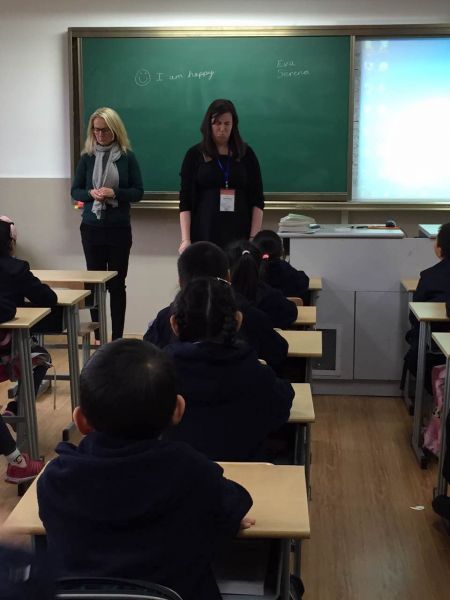
.JPG)
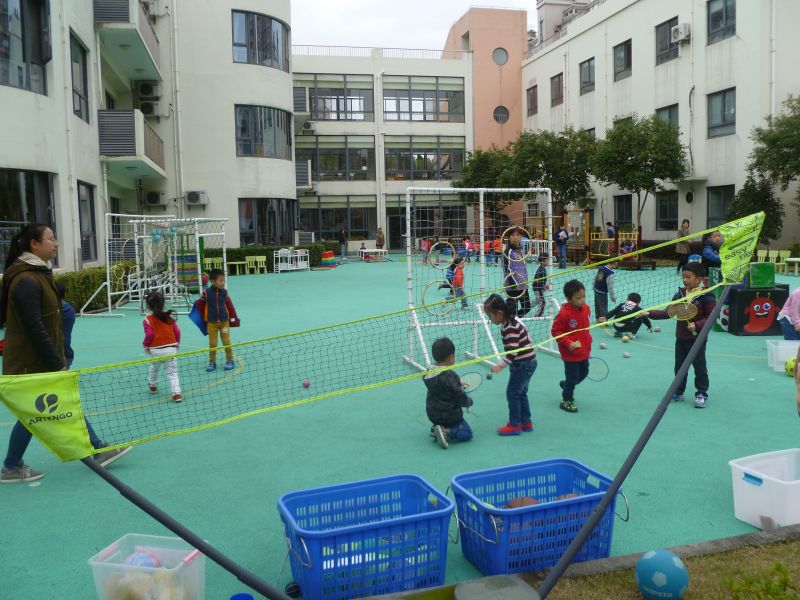
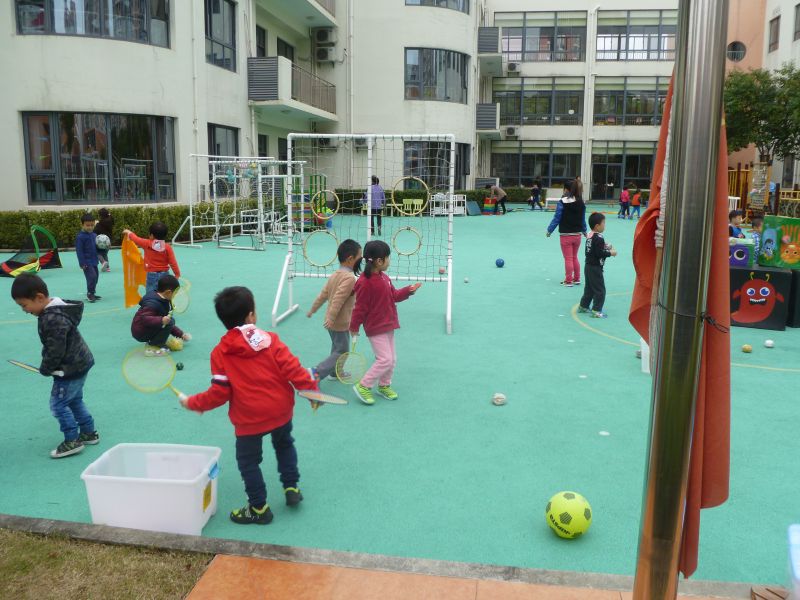
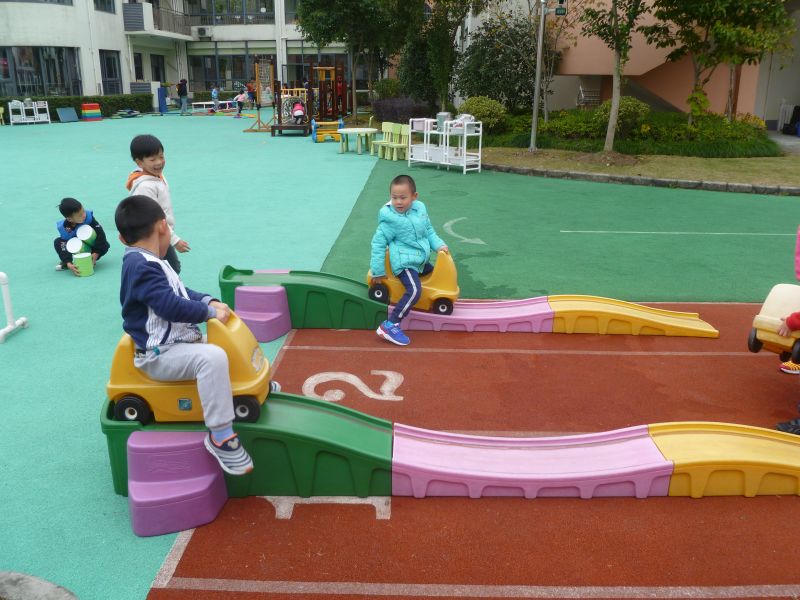
.JPG)
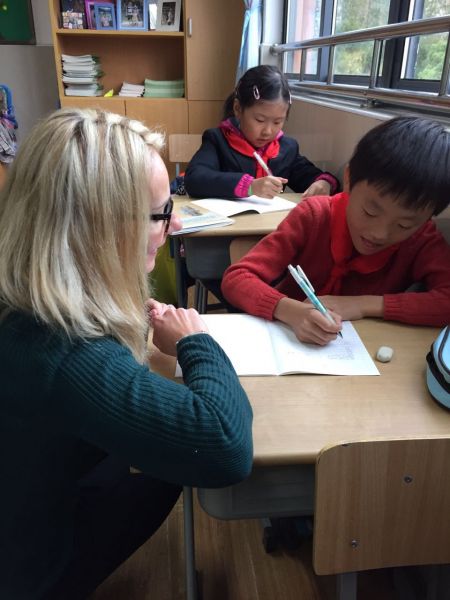
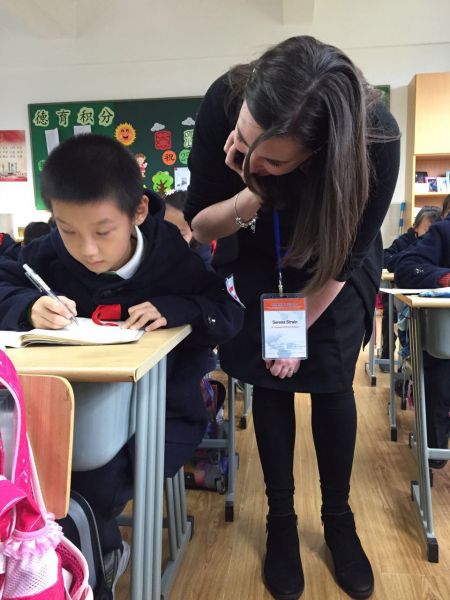
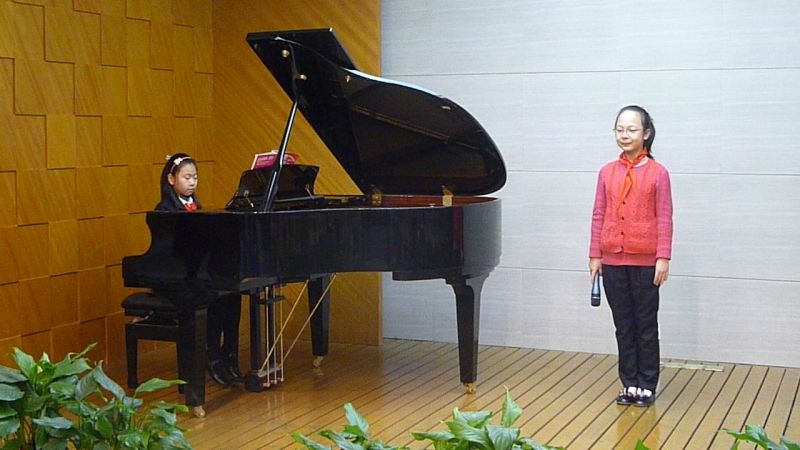
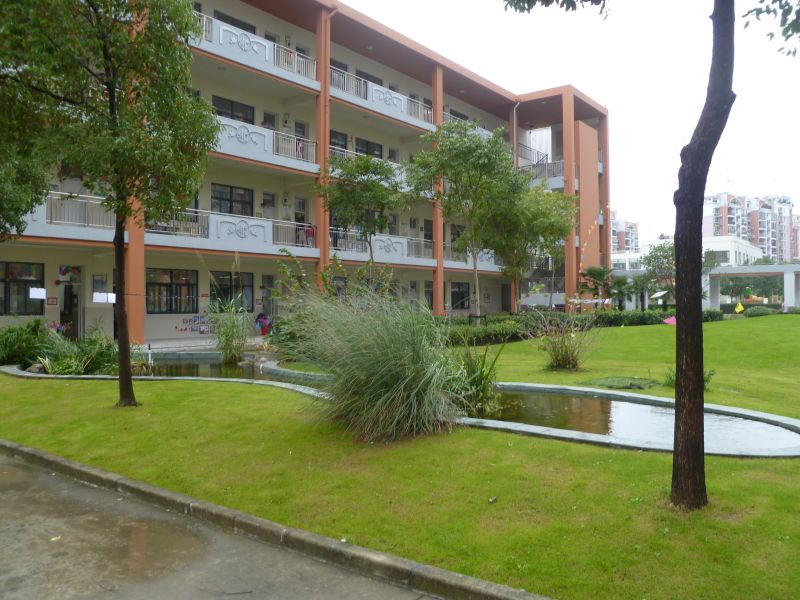
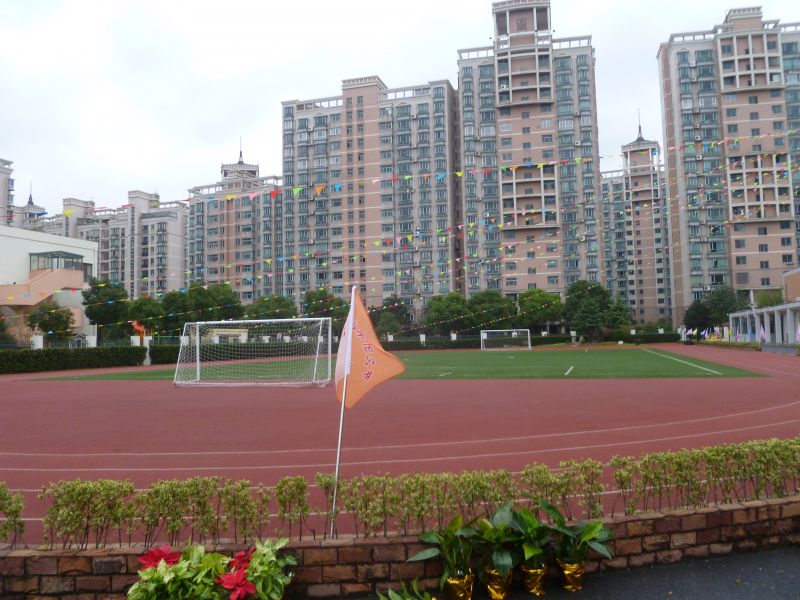
.JPG)
.JPG)
